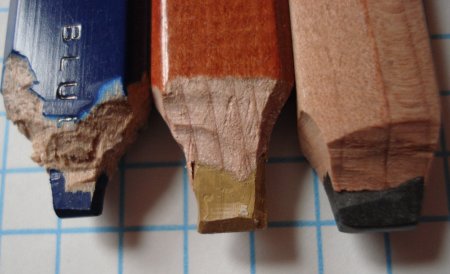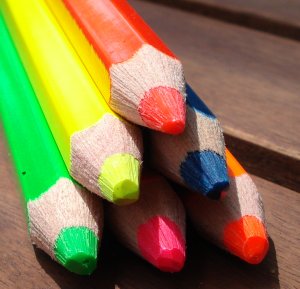
An interesting traditional specialty pencil is the red and blue pencil. Still manufactured today, this pencil is one half red, one half blue. (Both lead and varnish.)
While accounting, school, and editorial uses for this pencil may be traditional, I can imagine many other functions, including U.S. political consultants using these to plot on electoral maps.

Though I saw an interesting Koh-I-Noor at Lexikaliker, the three pencils I was able to quickly acquire from the excellent pencilthings.com were:
Musgrave Hermitage Thin 525 Red and Blue Combination
Musgrave Harvest Thick 725 Red and Blue Combination
Prismacolor Verithin 748 Red and Blue
The “Thin” and “Thick” labels of the Musgrave refer to the pencil cores – not the pencil diameter. The shape is the externally distinguishing feature – the Hermitage is hexagonal, while the Harvest is round. The Prismacolor pencil is also round.

While attempting sharpening, I found the leads of both Musgrave pencils to repeatedly break in a variety of sharpeners – especially the red ends. The Hermitage in particular seemed extremely averse to sharpeners. The Prismacolor pencil had no such problems.
As pencils, each had merits – the Prismacolor had the richest and most vibrant colours – so it would be the best on a blank sheet – yet the lighter and more muted tones of the Musgraves might be better for correction on a printed page.
Oddly enough, while preparing this post on the weekend, I saw a red and blue pencil used in the film “The Ninth Gate”. Johnny Depp’s character (a rare book dealer) uses this type of pencil to take notes:

In appearance, these pencils are a great blast from the past, and both Musgraves having great styled details. The Prismacolor has a serious presentation issue – the blue end appears to be a type of foil on top of the red varnish. Since the pencil shipped with a bar code sticker on the blue end, the foil now looks extremely dated and tattered. Almost like the fallen disco ball on that bad remake of the Poseiden Adventure.

Despite some issues, I think the Prismacolor Verithin is the best of the lot – reliable sharpening, and rich vibrant colour.










